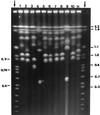Biotyping and virulence properties of skin isolates of Candida parapsilosis
- PMID: 10523538
- PMCID: PMC85673
- DOI: 10.1128/JCM.37.11.3481-3486.1999
Biotyping and virulence properties of skin isolates of Candida parapsilosis
Abstract
The biotype and virulence of skin isolates of Candida parapsilosis were compared with blood isolates of the same fungus. Morphotype, resistotype, and electrophoretic karyotype determinations did not reveal any special cluster with a unique or dominant pathogenic feature among all of the isolates, regardless of their source. However, all cutaneous isolates had uniformly elevated secretory aspartyl-protease (Sap) activity, more than four times higher than the enzyme activity of the blood isolates. They were also highly vaginopathic in a rat vaginitis model, being significantly more virulent than blood isolates in this infection model. In contrast, skin isolates were nonpathogenic in systemic infection of cyclophosphamide-immunodepressed mice, while some blood isolates were, in this model, highly pathogenic (median survival time, 2 days, with internal organ invasion at autopsy). Finally, skin isolates did not differ, as a whole, from blood isolates in their adherence to plastic. This property was associated with a morphotype, as defined by a colony with continuous fringe, which was present among both skin and blood isolates. While confirming the genetic heterogenicity of C. parapsilosis, our data strongly suggest that the potential of this fungus to cause mucosal disease is associated with Sap production and is substantially distinct from that of systemic invasion.
Figures


References
-
- Bistoni F, Vecchiarelli A, Cenci E, Sbaraglia G, Perito S, Cassone A. A Comparison of experimental pathogenicity of Candida species in cyclophosphamide-immunodepressed mice. Sabouraudia. 1984;22:409–418. - PubMed
-
- Cassone A, De Bernardis F, Pontieri E, Carruba G, Girmenia C, Martino P, Fernandez-Rodriguez M, Quindos G, Ponton J. Biotype diversity of Candida parapsilosis and its relationship to the clinical source and experimental pathogenicity. J Infect Dis. 1995;171:967–975. - PubMed
Publication types
MeSH terms
Substances
LinkOut - more resources
Full Text Sources
Miscellaneous

